Searching for the ultimate design born from a pursuit of functionality
Kobelco Construction Machinery’s excavators are strong and durable for the toughest worksite conditions. Keeping a step ahead in the industry, every machine is designed for low fuel consumption and low noise, addressing several issues to ensure that they are environment friendly. This time, we exhibited our new concept model SK75SR-7 at the CSPI-EXPO in May 2019, a machine that combines the aforementioned performance with “design”. We are confident that this concept model is our new coordination between performance and design.
Interior design group leader, Shintaro Sakitani mentions, “While overseas manufacturers come to the forefront, Kobelco Construction Machinery was able to show its innovative ideas more, resulting in the fruition of the “performance x design” concept throughout this development project.”
Sakitani continued to explain that the ideas went beyond the visual aspects:
 Design evaluation was conducted by each of the departments
Design evaluation was conducted by each of the departments
and overseas subsidiaries
Position optimization based on actual survey data
The project started with reviewing the position optimization of the operator in the cab. The team pursued the ideal seating position with Hiroshima University through industry-academia collaboration based on the KOBELCO Construction Machinery Dream-Driven Co-Creation Research Center. First, we attached electrodes at each point of an operator’s body to measure changes in the myoelectricity of the muscles while operating a machine.
Based on that actual data, we proceeded to optimize the positions of the control devices and switches including those for seat height and levers, taking into account aspects such as ergonomics and sensitivity engineering to achieve an operating posture that is highest in productivity and lowest in physical burden.
Keiji Yamamoto, a member of Sakitani’s interior design group, said there were several discoveries through the research.
We also discovered that the operator’s optimum position was realized when they gripped the levers with elbows gently bent. With this point in mind, the angle of the levers were raised compared with the conventional and positioned closer to the operator’s body.
In short, the team proceeded with the measurement experiment using the height measurement of an average Japanese individual and attempted to achieve the best matching position for smaller framed women and large framed foreigners as well. For that purpose, several individuals with different sizes and shapes were asked to sit in a functional mock-up, and monitored to see how they would adjust their seat to achieve their best position.
The interior coloring is a two-toned, black and gray, featuring a high-quality chic that is popular abroad.
 Pursuing both functionality and operability, the cab is designed to minimize the physical burdens associated with operation. From the abundant quality emphasized by the chic coloring to the position of air conditioning outlet, every idea has been implemented to ensure the superiority of an individual.
Pursuing both functionality and operability, the cab is designed to minimize the physical burdens associated with operation. From the abundant quality emphasized by the chic coloring to the position of air conditioning outlet, every idea has been implemented to ensure the superiority of an individual.
 Lever positions were changed according to the myoelectricity measurements of an operator’s muscles
Lever positions were changed according to the myoelectricity measurements of an operator’s muscles
Exterior design effects contributing towards visual range, workability and rigidity
Several innovations were introduced for the exterior as well. Hironori Tsukamoto, a member of upper design group, recollects, “Keeping the tank’s volume capacity, we lowered it from its conventional position to enhance visual observation. We had a hard time jockeying for space inside the body,but, we were able to place the fuel filler port at an accessible height from the ground as a result, which improved the task of refueling.”
In addition, the machine was standardly equipped with an “eagle-eye view”, which has cameras on the rear, right and left of the body. This provided a 270 degree on-screen view of the surrounding area and significantly improved the safety aspect of the machine. Also, the body’s rear portion was divided into blocks with a wild irregularity by eliminating decorative ornamentation shch as decals, to produce a heavy duty image.
 Standardly equipped with cameras on the rear, right and left to provide 270-degree “eagle-eye view” of the machines surroundings.
Standardly equipped with cameras on the rear, right and left to provide 270-degree “eagle-eye view” of the machines surroundings.
 Perception and visibility were improved with a large 10-inch display. Special attention was also given to color tone and icon design.
Perception and visibility were improved with a large 10-inch display. Special attention was also given to color tone and icon design.
Improved comfort by intuitive software and high texture interior decoration
On the other hand, improving the functions and values of products cannot be done without upgrading the current software. With the SK75SR-7, major reforms of software were also made. Jun Tsuruta, a member of the electric control engineering group said, “We particularly focused our efforts on areas such as the video display of onboard cameras, equipping with the industry’s largest 10-inch color monitor and enhancing the user interface in terms of screen configuration and icon design.” Safety verification can now be easily conducted by selecting either a 2-camera display or an eagle-eye view display using the onboard cameras.
Moreover, the group reviewed the shape of each icon to make the visual expression even easier to understand.
For the exterior and interior as well as the design image of the screen, several in-house evaluation meetings were held to gather the opinions of staff members from each department and from the overseas subsidiaries based in Europe and North America. In addition, in-cab coloring and related evaluations were gathered and reflected on the same day using a virtual reality system.
For this project, a spiral development method of repeated modifications was used, based on short and quick evaluations of the prototype by combining the virtual evaluations of a functional mock-up and virtual reality.
Within that situation, the front-loading of development will progress, product precision will improve, and the compression of both development period and the market introduction cycle will accelerate. Kobelco Construction Machinery will remain focusing on the customer’s viewpoint and balancing the function and design of its hydraulic excavators.
 The members who were leading this project.
The members who were leading this project.
From left to right: Jun Tsuruta, Shintaro Sakitani, Keiji Yamamoto, Hironori Tsukamoto
text by Toshiyuki Ota /photographs by Osamu Kobayashi
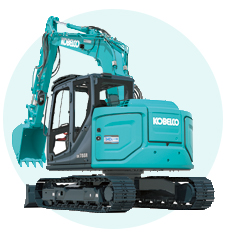
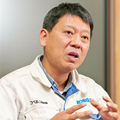
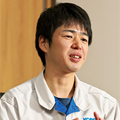
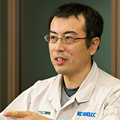
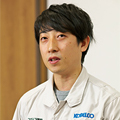






Sakitani
As an example, the forms of airplanes and F1 machines were born as a result of pursuing aerodynamic design and functionality as well as operability to achieve speed. In developing our SK75SR-7, we improved speed and power for productivity and also enhanced its operability at the same time. As a result, a product that pursued “functional beauty” was made.